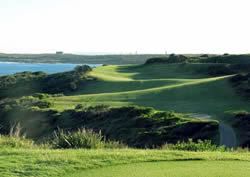And, it wasn't my idea that these flattish holes were "Alps" holes, at least a couple of them were still named as such on the scorecard, presumably from opening day. Macdonald told Raynor that the Alps was one of the most important hole types and he tried to do one everywhere, even on flat ground ... but he didn't necessarily see the point of building a hill to make it blind, for him it was about having a forced carry over a bunker right in front of the green.
As they say in Australia. That's not an Alps Hole... this is an Alps Hole!*

Reading Tom Doak's post about Raynor not having visited Scotland, perhaps he did not fully appreciate how small a rise is required on linksland to create a blind shot. When I first visited St. Andrews, I was struck by the fact that an 8 ft rise might as well be 30 ft in terms of how difficult it was to determine the correct line of play.
If you go by the template of the 17th at Prestwick, it seems both the drive and the approach should be a 'blind' shot i.e. you can't see where your ball stops. On the second shot this can be achieved when the level of the green beyond the bunker is just a few feet above your eyeline in the fairway.
* Perhaps not, as the bunker in the front of the green was converted to a grass bunker due to extreme wind conditions. An archival photo shows a sand bunker was in play after the war, but filled in some time during the 60s. The fact that Bob Harrison from Great White Shark did not reinstitute it as a sand bunker when they revetted the other 'at risk' bunkers during the 90's was the right decision.
The pitch from a fluffy lie is not a common shot at NSW. Due to the slope of the green it is perhaps the most challenging short game shot on the course.